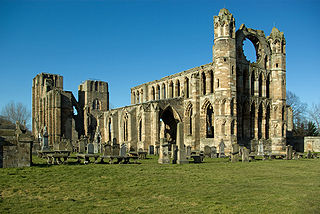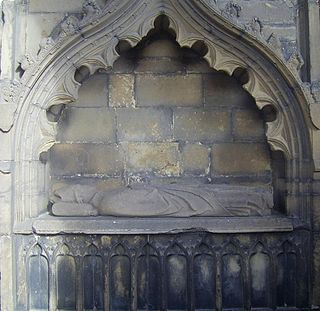
Elgin Cathedral is a historic ruin in Elgin, Moray, north-east Scotland. The cathedral, dedicated to the Holy Trinity, was established in 1224 on land granted by King Alexander II outside the burgh of Elgin and close to the River Lossie. It replaced the cathedral at Spynie, 3 kilometres (2 mi) to the north, which was served by a small chapter of eight clerics. By 1226, the new and developing cathedral was staffed with 18 canons increasing to 23 by 1242. A damaging fire in 1270 resulted in a significantly enlarged building. It remained unaffected by the Wars of Scottish Independence, but again suffered extensive fire damage in 1390 when attacked by Robert III's brother Alexander Stewart, Earl of Buchan, also known as the Wolf of Badenoch. In 1402 the cathedral precinct again suffered an incendiary attack by the followers of the Lord of the Isles.
The Bishop of Moray or Bishop of Elgin was the ecclesiastical head of the Diocese of Moray in northern Scotland, one of Scotland's 13 medieval bishoprics. If the foundation charter of the monastery at Scone is reliable, then the Bishopric of Moray was in existence as early as the reign of King Alexander I of Scotland (1107–1124), but was certainly in existence by 1127, when one Gregoir ("Gregorius") is mentioned as "Bishop of Moray" in a charter of king David I of Scotland. The bishopric had its seat at Elgin and Elgin Cathedral, but was severally at Birnie, Kinneddar and as late as Bishop Andreas de Moravia at Spynie, where the bishops continued to maintain a palace. The Bishopric's links with Rome ceased to exist after the Scottish Reformation, but continued, saving temporary abolition between 1638 and 1661, under the episcopal Church of Scotland until the Revolution of 1688. Episcopacy in the established church in Scotland was permanently abolished in 1689. The Bishops fortified seat for over 500 years was at Spynie Palace.

Alexander de Kininmund was a 14th-century Scottish cleric. Although it is not known which one, it is known that in his youth he went to university and achieved a Licentiate in the Arts.

Henry de Lichton [de Lychtone, Leighton] was a medieval Scottish prelate and diplomat, who, serving as Bishop of Moray (1414–1422) and Bishop of Aberdeen (1422–1440), became a significant patron of the church, a cathedral builder, and a writer. He also served King James I of Scotland as a diplomat in England, France, and Italy.

John de Innes was medieval Scottish churchman. Born probably in Moray, he went to France in his youth, receiving a bachelorate in civil law from the University of Paris by 1396 and in canon law by 1407. His education was partly paid for by the prebend of Duffus and a grant from Alexander Bur, Bishop of Moray, taken by Bur from the judicial profits of his diocese. During Innes' study period, he was also pursuing an ecclesiastical career, being Archdeacon of Caithness from 1396 until 1398, and Dean of Ross, from some point between 1396 and 1398 until 1407.

John de Winchester was a 15th-century English cleric who distinguished himself as an administrator and bishop in Scotland. Winchester was a student of canon law from 1418, graduating with a bachelorate in 1421.

David de Moravia was Bishop of Moray during most of the First War of Scottish Independence. He was elected Bishop of Moray, probably in early 1299. Extended details exist regarding the election because of an extant letter of Pope Boniface VIII. The result of the election was that David had 13 votes, the Dean had 4 votes, the Chancellor had 3 votes and the Archdeacon 1 vote. The Dean declared that David was elected, and sent a request for confirmation to the Papacy. The latter found an irregularity, though what exactly this was not revealed. The election result was nominally declared void, but the Pope himself provided David directly to the bishopric. He was consecrated as bishop at Anagni in Italy on 28 June 1299, by Matthew of Aquasparta, Cardinal-Bishop of Porto.
John de Pilmuir [Pilmor, Pylmore] was a 14th-century prelate based in Scotland. He was probably the son of Adam de Pilmuir, a Dundee burgess, and the brother of Richard de Pilmuir, Bishop of Dunkeld (1337/38–1345/47).
William de Spynie was a Scottish prelate. He was a canon of Moray by 1363 and Precentor (Chanter) of Aberdeen in 1371. By 1372 x 1373, he had exchanged the latter position with William Boyl for the Precentorship of Moray. He had become Dean of Aberdeen by 1388. It is possible he had become Dean of Dunkeld in 1397, though this may be a mistake in the source, "Aberdeen" rather than "Dunkeld" being meant. At any rate, in that year he was elected as the Bishop of Moray. He travelled to France and on September 1397 was consecrated as Bishop.
David Stewart was a prelate from 15th century Scotland. A member of the Stewart kindred of Lorne, he is known to have held a succession of senior ecclesiastical positions in northern Scotland before eventually succeeding his brother James Stewart as Bishop of Moray.

Andrew Stewart was a 15th-century Scottish prelate and administrator.

Gilbert was a 13th-century Cistercian monk, abbot and bishop. His first appearance in the sources occurs under the year 1233, for which year the Chronicle of Melrose reported that "Sir Gilbert, the abbot of Glenluce, resigned his office, in the chapter of Melrose; and there he made his profession". It is not clear why Gilbert really did resign the position of Abbot of Glenluce, head of Glenluce Abbey in Galloway, in order to become a mere brother at Melrose Abbey; nor is it clear for how long Gilbert had been abbot, though his latest known predecessor is attested last on 27 May 1222. After going to there, Gilbert became the Master of the Novices at Melrose.
Odo Ydonc was a 13th-century Premonstratensian prelate. The first recorded appearance of Odo was when he witnessed a charter by Donnchadh, Earl of Carrick, on 21 July 1225. In this document he is already Abbot of Dercongal, incidentally the first Abbot of Dercongal to appear on record.
Ingram de Ketenis was a medieval cleric from Angus in Scotland.
Thomas de Buittle [Butil, Butill, Butyll, Butyl, Bucyl] was a Scottish prelate, clerk and papal auditor active in the late 14th and early 15th centuries. Probably originating in Galloway, Scotland, Thomas took a university career in canon law in England and France, before taking up service at the court of Avignon Pope Benedict XIII. He obtained a number of benefices in the meantime, including the position of Archdeacon of Galloway, and is the earliest known and probably first provost of the collegiate church of Maybole. The height of his career came however when the Pope provided him to the bishopric of Galloway, a position he held from 1415 until his death sometime between 1420 and 1422.
Robert de Fyvie [also de Fyvin] was a prelate based in the Kingdom of Scotland in the last quarter of the 13th century. Perhaps coming from Fyvie in Formartine, from a family of Teesdale origin, Robert was Archdeacon of Ross and a student at the University of Bologna by 1269. In 1275, he was not only a graduate but the new Bishop of Ross, a post he held until his death in the first half of the 1290s.
Alexander Stewart was a 14th-century Scottish bishop. Probably from Menteith, he appears in the sources from the first half of the 1340s, possessing a university degree and holding the position of Archdeacon of Ross. He was active at the papal curia in the second half of the decade as a papal chaplain and administrator, before being provided as Bishop of Ross in 1350, a position he held until his death in 1371.
Alexander de Kylwos – written alternatively as Frylquhous, Kylquos, and a variety of other forms – was a Scottish churchman and prelate active in the second half of the 14th century. He is known to have held senior positions in three bishoprics, and senior offices in two, before being elected and appointed Bishop of Ross in 1371. Though his episcopate is relatively obscure, he seems to have spent almost all of it inside or around his province, was closely associated with William III and Euphemia I, successive rulers of Ross, and was an associate of the famous Alexander Bur, Bishop of Moray, during the latter's struggle with Alexander Stewart, the son of the King later known by the nickname "Wolf of Badenoch".

Kinneddar is a small settlement on the outskirts of Lossiemouth in Moray, Scotland, near the main entrance to RAF Lossiemouth. Long predating the modern town of Lossiemouth, Kinneddar was a major monastic centre for the Pictish kingdom of Fortriu from the 6th or 7th centuries, and the source of the important collection of Pictish stones called the Drainie Carved Stones. The Kirk of Kinneddar was the cathedral of the Diocese of Moray between 1187 and 1208, and remained an important centre of diocesan administration and residence of the Bishop of Moray through the 13th and 14th centuries.








